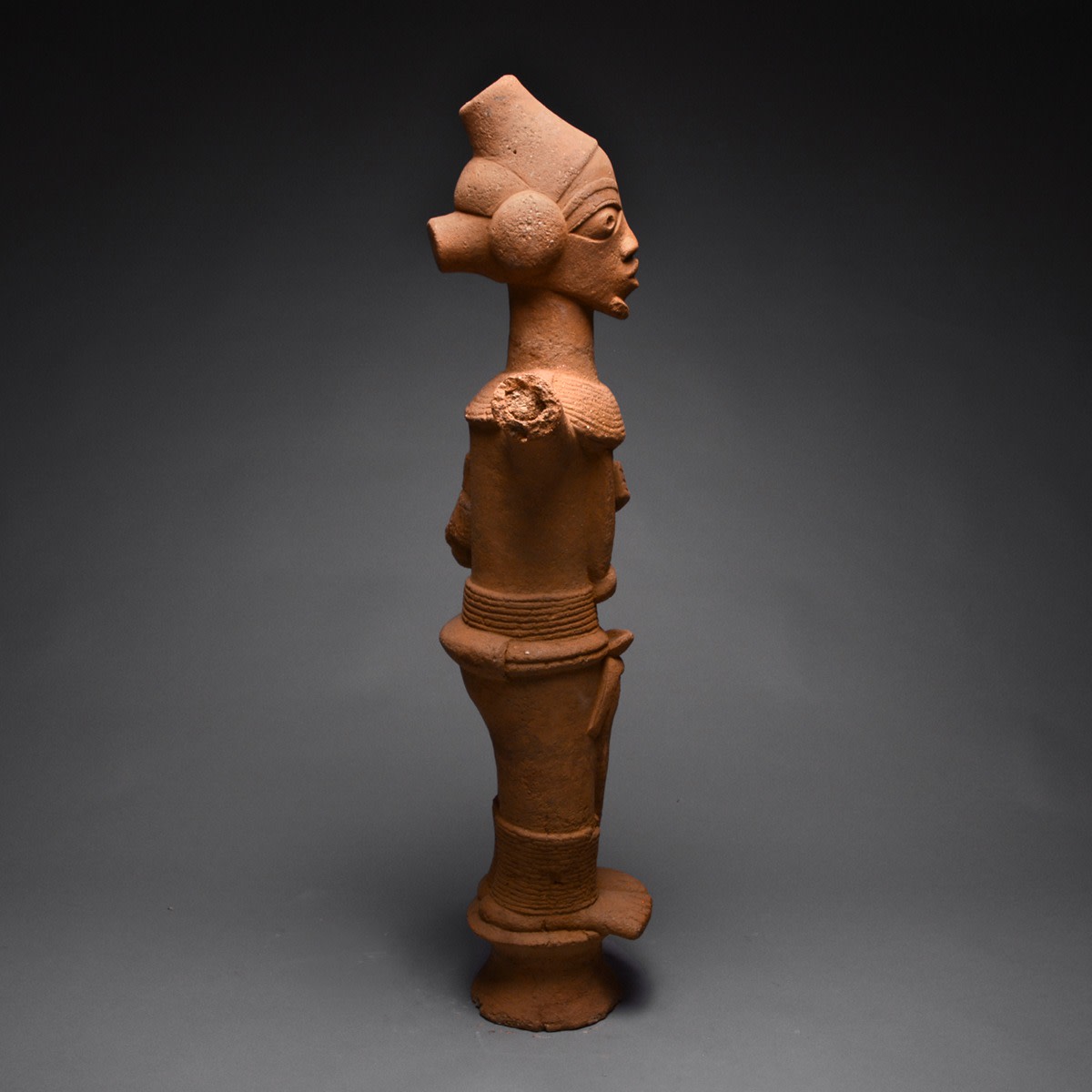Nok Terracotta Figure, 300 BCE - 200 CE
Terracotta
height 96.5 cm
height 38 in
height 38 in
GC.104 (LSO)
Further images
This is a highly unusual Nok piece, which bears markers of the “Classical” Nok style but which deviates substantially from the norm for that group. The general pattern of rendering...
This is a highly unusual Nok piece, which bears markers of the “Classical” Nok style but which deviates substantially from the norm for that group. The general pattern of rendering is traditional, with a standing male (?) figure atop a pedestal base which may have been part of a large vessel with this piece as the lid handle/finial. The rendering is of a very high quality, with detailing of jewellery and minor anatomical points picked out with considerable care. The legs are pressed together and the left arm flexed into the abdomen. The face has a somewhat plaintive expression, and is surmounted with a tall, conical hat with a flat top. The proportions of the figure are naturalistic, unusually, including the head. This piece therefore most likely subscribes to the Jemaa style (see below). It is exceptionally glossy, which may mean a treatment of the terracotta after it was made, or perhaps a series of libations during its functional life.
The astonishing artistry and early date of Nok pieces makes them among the most important artworks on the African continent. Comparatively little is known of the Nok culture, although the entity – which flourished between 900 BC and 200 AD – is technically a misnomer, for the artistic traditions it represents are the only common characteristics shared by communities that differed in most other respects. Their artworks constitute the most sophisticated and formalised early African artistic tradition outside Egypt. Technically, they are very unusual because of the manner in which coiled and subtractive sculpting methods were used to capture likenesses. Aesthetically, they are both naturalistic and expressionist, with highly distinctive elongated forms, triangular eyes, pierced pupils/nostrils and elaborate hairstyles. Substyles of the Nok tradition include the Jemaa Style, the Katsina Ala Style (elongated heads) and the Sokoto Style (elongated monobrow foreheads, lending a severe expression to the face) and random variants such as the Herm Statues of Kuchamfa (simplified cylindrical figures topped with normal heads) and the “standard” three-dimensional standing figures, which subscribe to the Jemaa style; this is the attribution of the current piece.
The function of Nok art is unclear, although the care with which it is executed has led some to claim they represent nobility, or perhaps ancestors to which obeisance and sacrifices were offered. The largest ones may have been placed in structures that had ceremonial or ritual importance at the time, while smaller ones may have been personal or domestic talismans or deities/spirits. They are always socially elevated insofar as this can be ascertained (i.e. jewellery, weaponry) although the lack of context makes this speculative at best. The presence of bases that are hollowed and/or broken has led academics to suggest that they were the tops of very large vessels, perhaps used as sacrificial or tributary pieces.
This is an impressive piece of Nok art.
The astonishing artistry and early date of Nok pieces makes them among the most important artworks on the African continent. Comparatively little is known of the Nok culture, although the entity – which flourished between 900 BC and 200 AD – is technically a misnomer, for the artistic traditions it represents are the only common characteristics shared by communities that differed in most other respects. Their artworks constitute the most sophisticated and formalised early African artistic tradition outside Egypt. Technically, they are very unusual because of the manner in which coiled and subtractive sculpting methods were used to capture likenesses. Aesthetically, they are both naturalistic and expressionist, with highly distinctive elongated forms, triangular eyes, pierced pupils/nostrils and elaborate hairstyles. Substyles of the Nok tradition include the Jemaa Style, the Katsina Ala Style (elongated heads) and the Sokoto Style (elongated monobrow foreheads, lending a severe expression to the face) and random variants such as the Herm Statues of Kuchamfa (simplified cylindrical figures topped with normal heads) and the “standard” three-dimensional standing figures, which subscribe to the Jemaa style; this is the attribution of the current piece.
The function of Nok art is unclear, although the care with which it is executed has led some to claim they represent nobility, or perhaps ancestors to which obeisance and sacrifices were offered. The largest ones may have been placed in structures that had ceremonial or ritual importance at the time, while smaller ones may have been personal or domestic talismans or deities/spirits. They are always socially elevated insofar as this can be ascertained (i.e. jewellery, weaponry) although the lack of context makes this speculative at best. The presence of bases that are hollowed and/or broken has led academics to suggest that they were the tops of very large vessels, perhaps used as sacrificial or tributary pieces.
This is an impressive piece of Nok art.





